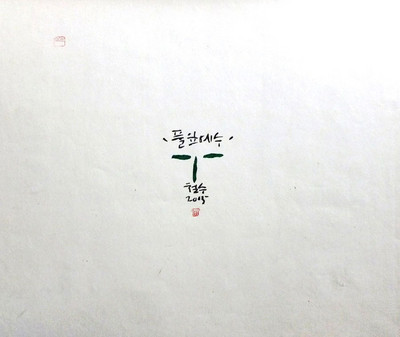
Lee Chul Soo
Jesus, the Blade of Glass
Woodblock print
Seeing an icon of your faith through the eyes of a believer in another great world religion can be an enriching experience. Lee Chul Soo, the South Korean printmaker who created this simple woodblock print is a practitioner of Zen Buddhism. In the 1980s, he was involved in the Minjung (people’s) art movement, when South Korean artists joined popular protests to bring down the country’s military dictatorship. With the restoration of democracy in 1987, Lee Chul Soo moved with his family to a small rice farm in the countryside, where he now raises most of his own food and makes prints, breaking down the boundary lines between word and image. What might appear to be a crown of thorns and beard, framing three green lines, suggestive of the eyes and nose of Christ, is actually calligraphic script, reading “Jesus, the Blade of Grass.” The tile of the piece may be an allusion to a Zen Buddhist koan (a pithy saying or story), telling how the Buddha was once out walking with his disciples and stopped to point to a patch of ground, saying: “This is a good place to build a sanctuary.” Indra, the King of the Gods, took a blade of grass, planted it in the ground, and replied: “The sanctuary is built.” The tale brings to mind Jesus’ teaching in John 12: 24 (NIV): “Unless a kernel of wheat falls to the ground and dies, it remains only a single seed. But if it dies, it produces many seed.” Against an empty space, recalling a barren field or paddy, the South Korean rice farmer-printmaker depicts the first sprouts of new growth--rice, grass, or wheat--with beautifully minimalist markings. (John Kohan)
